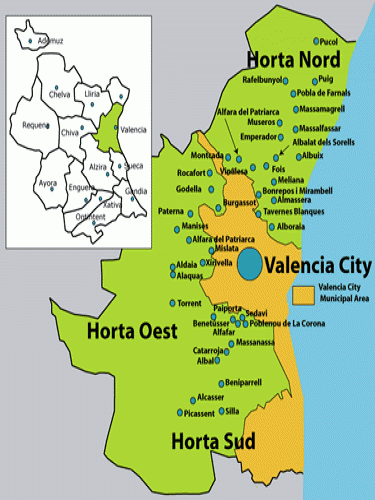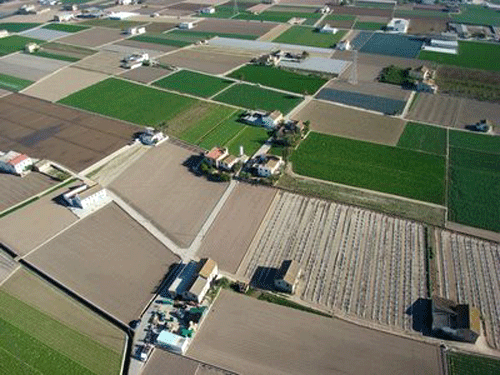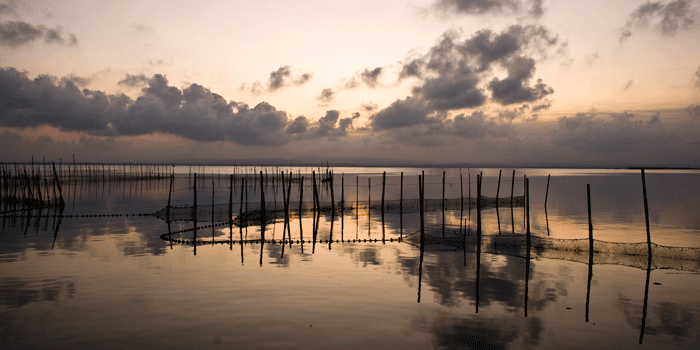 The comarca of Horta de Valencia contains one third of the population of Valencia Province. Since the early Islamic era the Horta lands were the most densely populated territory. It was the Muslims who created the infrastructure needed to exploit the agricultural wealth of this region, building canals, dams, windmills and took advantage of the water from the Turía.
The comarca of Horta de Valencia contains one third of the population of Valencia Province. Since the early Islamic era the Horta lands were the most densely populated territory. It was the Muslims who created the infrastructure needed to exploit the agricultural wealth of this region, building canals, dams, windmills and took advantage of the water from the Turía.
The farming land is still maintained close to the City and retains the traditional aspects of Valencian life. There are eight major canals: Montcada, Tormos, Mestalla, Rascanya, Quart-Benages-Faitanar, Mislata, Favara and Mold, and there are eight major channels: Montcada, Tormos, Mestalla, Rascanya, Quart-Benages-Faitanar, Mislata and Favara. These are all governed by the Tribunal De Las Aguas De La Vega De Valencia, which meets at the door of the Cathedral of Valencia.
Typically the climate is Mediterranean, having mild winters and very hot summers. Historically the traditional activity of the region has been agriculture, with a predominance of three types of crops: oranges, vegetables and rice. The irrigation system is structured around 13 channels that allow irrigated crops throughout the year. Some municipalities have a specialization in specific crops: groundnuts in Alboraya and Almàssera; tomatoes and peppers for canning in El Puig, Puçol and Tavernes Blanques; strawberries, watermelons in Rafelbunyol and the production of horchata in Almàssera. Rice growing is diminishing but continues to be cultivated on the edges of La Albufera lagoon
The area is heavily industrialized including textile, ceramic, porcelain, paper and textile factories. The industries are situated in the towns spread across L´Horta. However, Many of the towns are bordered by agricultural land that camouflage the industrial nature of the town
The capital of the region is Valencia with more than 760.000 Inhabitants; after Barcelona, Its port is the second biggest in the Spanish Mediterranean although it exceeds Barcelona in the transportation of shipping containers
The Pla de L'Horta
 According to a Government statement this area will help absorb 250,000 tons of CO2 per year (provided that agricultural products are consumed in nearby markets).
According to a Government statement this area will help absorb 250,000 tons of CO2 per year (provided that agricultural products are consumed in nearby markets).
The Protection Plan aims for Huerta to protect and preserve its agricultural values (scenic, cultural and heritage), and to create itineraries and routes, and to take advantage of the existing agricultural structure especially in using the historic network of roads and irrigation.
It also aims to maintain the landscape garden and rehabilitate the existing architectural heritage, to encourage sustainability criteria in socioeconomic activities, and the approach to urban governance arrangements that involve the protection and maintenance of the garden to the processes of land occupation.
The process of Public Participation Special Protection Plan de la Huerta de Valencia began in June 2008, when it became publicly available document on the website of the Department of Environment, which has received more than 1,300,000 queries. Have also developed outreach workshops, seminars and 11 exhibitions.


 The comarca of Horta de Valencia contains one third of the population of Valencia Province. Since the early Islamic era the Horta lands were the most densely populated territory. It was the Muslims who created the infrastructure needed to exploit the agricultural wealth of this region, building canals, dams, windmills and took advantage of the water from the Turía.
The comarca of Horta de Valencia contains one third of the population of Valencia Province. Since the early Islamic era the Horta lands were the most densely populated territory. It was the Muslims who created the infrastructure needed to exploit the agricultural wealth of this region, building canals, dams, windmills and took advantage of the water from the Turía. According to a Government statement this area will help absorb 250,000 tons of CO2 per year (provided that agricultural products are consumed in nearby markets).
According to a Government statement this area will help absorb 250,000 tons of CO2 per year (provided that agricultural products are consumed in nearby markets).